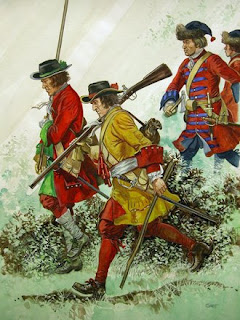Got some of the lyrics from the
Roxburghe ballads - they're around page 530. Referring to Charles Fort - if you look at the diary of
Halkett you will see Dumbartons were garrisoning Kinsale before Tangiers - hence the reference to 'no more Irish beer'.
Captain Hume is bound to sea :
Ho ! Captain Hume is bound to sea,
And his brave companie ;
Hey, the brave Granadeers,
Ho ! "We'll drink no more Irish Beer, Hey boyes, ho boyes,
"We'le drink no more Irish Beer, Ho !
We'll drink no more Irish Beer,
For we're all bound for Tangier ;
Hey, the brave Granadeers, Ho !
We'll drink tbe Spanish Wine ; Hey boyes, ho boyes !
We'll drink the Spanish Wine: Ho !
We'll drink tbe Spanish Wiue,
And court their Ladies fine,
Hey, the brave Granadeers, Ho !
Now we're upon tbe Sounds, Hey boyes, ho boyes :
Now we're upon the Sounds, Ho!
Now we're upon the Sounds,
Every man's health goes round,
Hey, the brave Granadeers, Ho !
When we came to Cails on Shore, Hey boyes, ho boyes,
When we came to Cails on Shore, Ho [= cails = Cadiz).
When we came to Cails on Shore,
We made the guns to roar,
Hey, the brave Granadeers, Ho !
Now we drink the Spanish Wine, Hey boyes, ho boyes:
Now we drink the Spanish Wine, Ho!
Now we drink tbe Spanish Wine,
And kiss their Ladies fine,
Hey, the brave Scottish boyes, Ho !
When we do view Tangier, Hey boyes, ho boyes !
When we do view Tangier, Ho !
Now we do see Tangier,
We'll make these proud Moores to fear :
Hy, the brave Granadeers, Ho !
A Proper New Ballad, The Granadeers' Rant.
When we come to Tangier shore,
Hey boyes, ho boyes !
When we come to Tangier shore, Ho !
When we land on Tangier shore,
We'll make our Granads to roar ;
Hey, the brave Granadeers ! Ho !
When we come upon the Mould, Hey boyes, ho boyes !
When we come upon the Mould : Ho !
When we come upon the Mould,
We'll make these proud Moores to yeeld :
Hey, the brave Scottish boyes, Ho !
When we come upon the Wall, Hey boyes, ho boyes !
When we come upon the Wall ; Ho !
When we come upon the Wall,
We'll make these proud Moores to fall ; Hey, the brave Granadeers ! Ho !
There's Hacket, Hume, and Hodge, Hey boyes, ho boyes !
There's Hacket, Hume, and Hodge, Ho !
There's Hacket, Hume, and Hodge,
In Charles's Fort shall lodge,
Hey ! the brave Granadeers, Ho !
Hacket led on the Van ; Hey boyes, ho boyes !
Hacket led on the Van : Ho ! Hacket led on the Van,
Where was killed many a man , Hey the brave Scottish boyes : Ho !
Sixty brave Granadeers ; Hey boyes, ho boyes !
Sixty brave Granadeers ; Ho ! Sixty brave Granadeers,
Beat the Moores from Tangiers, Hey the brave Scottish boyes, Ho !
finis.
[No colophon or woodcut. Blackletter. Date, probably circa 1680-83. These ' brave Granadeers ' were Dumbarton's regiment, the Royal Scots, ' Pontius Pilate's Guards,' who afterwards declared for James II. in March, 1689, aud many followed their colonel into Prance. With Kirke's Lambs they had garrisoned Tangier. ]

















































